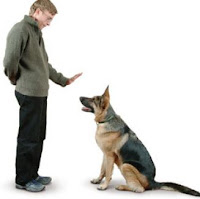
Most dogs engage in friendly jumping as a way to greet
people or play with them. First and foremost, most dogs have been trained to
jump-up since puppyhood. When the young pup jumped and pawed, most people patted
it on the head and scratched it behind the ear, because they were too lazy to
bend down to puppy level. And then one day the dog dutifully jumps-up to greet
its owner, who in turn greets the friendly furry with a whop on the butt or a
knee in the chest. The dog’s only crime? It grew!
Pawing, licking, and jumping-up are all friendly appeasement
gestures – the dog’s way of saying “Welcome home. Pleased to see you. Please
accept my presence. Please don’t hurt me.” By punishing your dog for jumping
up, the dog has two reasons to show deference – the initial reason and the fact
it must now appease an angry owner. And how does it try to appease the owner?
By pawing, licking, and jumping-up! This is one of the many paradoxes in
training – the more one punishes the dog, the more the behavior increases in
frequency.
In the case of jumping on guests, jumping must be prevented
100 percent of the time, but you may not be capable of doing so 100 percent of
the time. Let me introduce the concept of “training mode” and “non-training
mode.” Training mode is where you
actively work on the exercises you have been assigned when guests arrive, and a
non-training mode is where you
practice management, perhaps having the dog crated in another room when guests
arrive, rather than actively attempting to train. You should be in training
mode 80 to 90 percent of the time, and in management mode infrequently, such as
during a dinner party when training is impractical.
The dog must have a clear understanding of the alternate
behavior you prefer. In this case, a Sit or Sit-Stay is an appropriate
alternate behavior. The stronger the sit and sit-stay behaviors are by the
front door without guests present, the more likely the dog will be to perform
the behavior when guests are present. It is essential you reward your dog for
being calm in the presence of people.
Begin practicing the Sit and Sit-Stay cues at or near the
front door when no guest is present. Make sure the dog gets plenty of obedience
practice in all greeting locations he has failed in before or where he is
likely to greet guests in the future. Working basic obedience exercises around
mild distractions (e.g., opening and closing the front door) will also teach
the dog to focus on you and help develop impulse control. This will be
beneficial when you begin working with visitors.
Once you see your dog has begun to understand the cues in
the appropriate places, test them out! Upon returning to your home, instruct
your dog to sit, and delay greeting the dog until it does so. If your dog sits,
gently praise the dog. If your dog does not sit, keep trying until he does. Do
what it takes – take hold of the dog’s collar and keep hold until the dog
complies. This is no more difficult than routinely dealing with the dog in
everyday distracting situations. Only this time, you shall persevere, and
eventually, your dog will sit and be suitably praised for its trouble. Other
reprimands and punishments are neither necessary nor advisable. Your dog will
soon learn he has to sit before you will begin to say hello.

Once your dog’s exuberance has waned following the customary
display of sniffs, licks, wags and wiggles, slip out of the house by the back
door, ‘return home’ via the front door once more and request your dog to assume
the appropriate position. This time, however, it should be much easier to get
your dog to sit as he is not nearly as excited by your return because he has
only just greeted you seconds beforehand. After greeting your dog for the
second time, leave and repeat the procedure a third time, and then once more
and so on. Your dogs performance will improve with each repeated re-entry.
Post by Heather at Mickeyspetsupplies.com
Post by Heather at Mickeyspetsupplies.com

